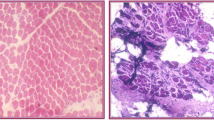Summary
A case of non-progressive congenital myopathy in a 14-month old male infant is described. The disorder is characterised histologically by a complete absence of Type II muscle fibres, hypoplastic Type I fibres of variable size and enlarged sarcolemmal nuclei. A neurogenic basis is proposed for this new myopathy.
Similar content being viewed by others
References
Brooke, M. H. and Engel, W. K. 1969. The histographic analysis of human muscle biopsies with regard to fiber types. 4. Children’s biopsies. Neurology (Minneapolis) 19, 591.
Conen, P. E., Murphy, E. G. and Donohoe, W. L. 1963. Light and electron microscopic studies of ‘myogranules’ in a child with hypotonia and muscle weakness. Canad. Med. Ass. J. 89, 983.
Dubowitz, V. 1963. Enzymatic maturation of skeletal muscle. Nature 197, 1215.
Dubowitz, V. 1967. Cross-innervated mammalian skeletal muscle: histochemical, physiological and biochemical observations. J. Physiol. 193, 481.
Dubowitz, V. and Brooke, M. H. 1973. The congenital myopathies.In Muscle Biopsy: A Modern Approach. London. W. B. Saunders Company. p. 253.
Dubowitz, V. and Newman, D. L. 1967. Change in enzyme pattern after cross-innervation of fast and slow skeletal muscle. Nature 214, 840.
Dubowitz, V. and Roy, S. 1965. Central core disease of muscle: clinical, histochemical and electron microscopic studies of an affected mother and child. Brain 93, 503.
Engel, A. G., Angelini, G. and Gomez, M. R. 1972. Fingerprint body myopathy. A newly recognized congenital muscle disease. Mayo Clin. Proc. 47, 377.
Engel, W. K., Gold, G. N. and Karpati, G. 1968. Type I fiber hypertrophy and central nuclei. Arch Neurol. 18, 435.
Gonatas, N. K., Perez, M. C., Shy, G. M. and Evangelista, I. 1965. Central core disease of skeletal muscle. Am. J. Path. 47, 503.
Inokuchi, T., Umezaki, H. and Santa, T. 1975. A case of type I fibre hypotrophy and internal nuclei. J. Neurol. Neurosurg. Psychiat. 38, 475.
Jenis, E. H., Lindquist, R. R. and Lister, R. C. 1969. New congenital myopathy with crystalline intranuclear inclusions. Arch. Neurol. 20, 281.
Matsuoka, Y., Guggay, S. S. and Kakulas, B. A. 1974. A new myopathy with type II muscle fibre hypoplasia. Proced. Aust. Ass. Neurol. 11, 151.
Mendell, J. R. and Engel, W. K. 1971. The fine structure of type II muscle fiber atrophy. Neurol. (Minn.) 21, 358.
Shy, G. M., Gonatas, N. K. and Perez, M. 1966. Two childhood myopathies with abnormal mitochondria. I. Megaconial myopathy. II. Pleoconial myopathy. Brain 89, 133.
Shy, G. M. and Magee, K. R. 1956. A new congenital non-progressive myopathy. Brain 79, 610.
Spiro, A. J., Shy, G. M. and Gonatas, N. K. 1966. Myotubular myopathy. Arch. Neurol. 14, 1.
Author information
Authors and Affiliations
Rights and permissions
About this article
Cite this article
Dinn, J.J., O’Doherty, N. Congenital Type II fibre deficient myopathy. IJMS 149, 53–58 (1980). https://doi.org/10.1007/BF02939111
Issue Date:
DOI: https://doi.org/10.1007/BF02939111




